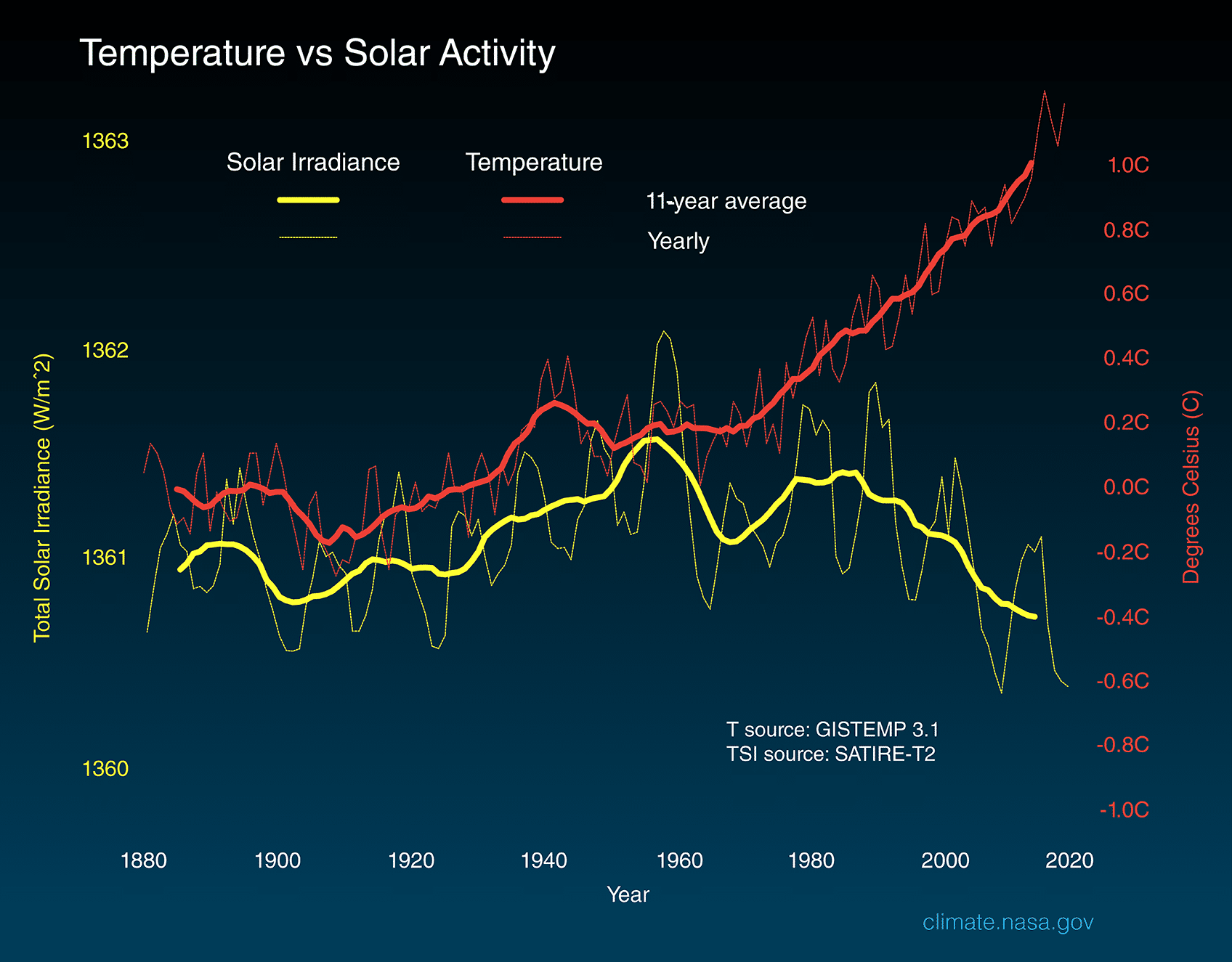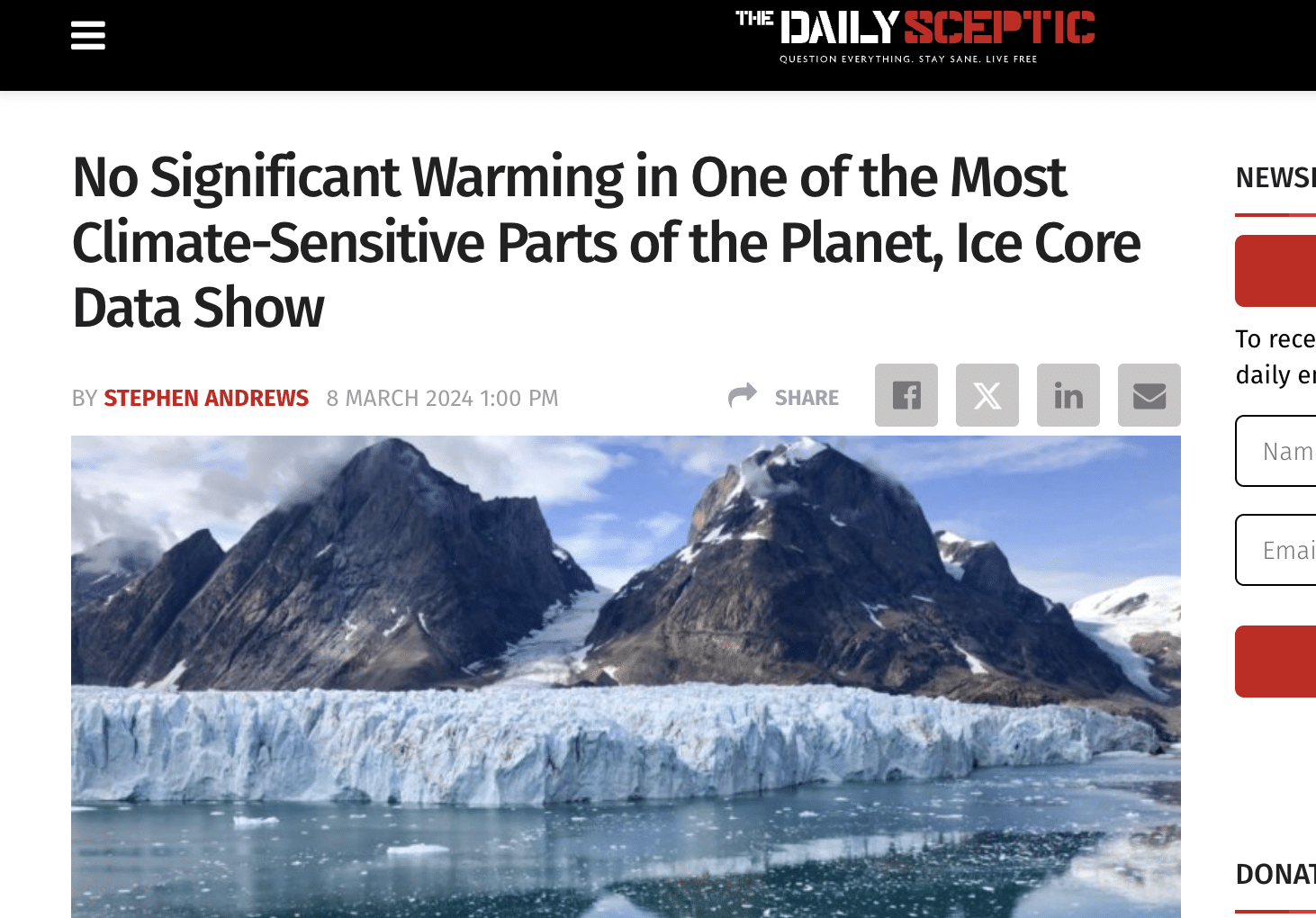- Climate
The sun isn’t responsible for current climate change, contrary to claims in Suspicious0bservers YouTube video
Key takeaway
Though the sun does go through regular solar cycles, changes in its activity – or in the Earth’s magnetic field – cannot account for our planet’s observed climate change. The sun has, historically, played a role in changes to the Earth’s climate, but the rate and magnitude of the Earth’s current warming is too high to be linked to changes in the sun or Earth’s orbit. The effect of rising rates of atmospheric greenhouse gases, on the other hand, has been well established by decades of scientific research.
Reviewed content

Verdict:
Claim:
Scientists have neglected the effect of solar particles, cosmic rays, the interplanetary magnetic field and Earth's weakening magnetic field to conclude climate change is due to human activity
Verdict detail
Incorrect: Scientists have established that human activities are responsible for the climate change observed over the last several decades and ruled out the possible influence of the sun or Earth’s magnetic field.
Full Claim
“They're able to blame us for climate change because they do not properly factor in the sun, how its activity has changed over the centuries…there's not one single paper in existence blaming humans for global warming which accounts for solar particles, cosmic rays, the interplanetary magnetic field and Earth's weakening magnetic field.”
On 14 July, 2022, YouTuber Ben Davidson published a video on his channel Suspicious0bservers which claims that the sun is at the root of the global warming that has been observed by scientists since the Industrial Revolution. Davidson, whose channel has more than 600,000 subscribers, claims that current climate science does not account for “solar particles, cosmic rays, the interplanetary magnetic field and Earth’s weakening magnetic field.”
But scientists haven’t found a link between those factors and significant changes to the planet’s climate, said Georg Feulner, Deputy Head of Research Department at the Potsdam Institute for Climate Impact Research. The warming effect of greenhouse gases, on the other hand, has been well established – as is the link between human activities and Earth’s current warming.[1]
“There is absolutely no doubt in the scientific community that the current climate crisis is due to human activities,” Feulner said in an email to Science Feedback.
One of the factors Davidson points to as driving current rates of climate change are coronal mass ejections (CMEs), phenomena defined by NOAA’s Space Weather Prediction Center as “large expulsions of plasma and magnetic field from the Sun’s corona.” Davidson cites a 2002 paper published in the Journal of Geophysical Research: Space Physics to support his claim that the sun produced twice the number of CMEs from 1940 to 2005 as it did a century earlier. In its abstract, the 2002 study notes: “We surmise that the coronal mass ejection (CME) rate for recent solar cycles was approximately twice as high as that for solar cycles 100 years ago.”[2]
Ian Richardson, a research scientist at NASA and the University of Maryland College Park and lead author of the 2002 study, told Science Feedback that that statement was a hypothesis of his – and, looking back on it now, probably an incorrect one.
“This was really just one hypothesis that I was considering to explain (unsuccessfully) the increase in geomagnetic activity in the first part of the 20th century, and is based on the simplest assumption that the CME rate is proportional to the sunspot number as suggested by studies published at that time based on direct observations of CMEs first available in the 1970s,” Richardson said in an email. “It is unreasonable to suggest that it’s an established fact as in the video.”
Coronal mass ejections aren’t associated with measurable changes to Earth’s temperature, because the magnetic field surrounding the Earth reflects the massive energy that CMEs put out back into space. This magnetic field, as NASA notes, “shields us from erosion of our atmosphere by the solar wind (charged particles our Sun continually spews at us), erosion and particle radiation from coronal mass ejections (massive clouds of energetic and magnetized solar plasma and radiation), and cosmic rays from deep space.”
Davidson, however, claims that a weakening of the Earth’s magnetic field has made it easier for the sun’s energy to warm the planet. According to NASA, Earth’s magnetic field has weakened by about 9 percent on average in the last 200 years – but “paleomagnetic studies show the field is about as strong as it’s been in the past 100,000 years, and is twice as intense as its million-year average.” And scientists don’t have reason to believe that, as Davidson claims, the Earth’s poles will be flipping anytime soon: Pole reversals take place over hundreds to thousands of years, and there is no guarantee that the Earth’s current magnetic field will continue weakening.[3]
“CMEs are short-lived events, and there is no evidence that the charged particles released from CMEs have a significant effect on the global climate, irrespective of the state of the Earth’s magnetic field,” Feulner said.
Davidson also points to a graph of the last four centuries of sunspot observations as evidence that the sun is playing a major role in current observed climate change. Sunspots are locations on the sun’s surface that are cooler than the rest of the sun, and their number tends to vary in approximately 11-year cycles. When sunspot activity is at a maximum, there tends to be a small increase in the sun’s energy output. But that output isn’t associated with major temperature changes: According to NOAA Climate.gov, scientists estimate that slight increases in levels of sunlight between the late 1800s and mid-1900s contributed to up to 0.1°C at most of the planet’s 1.0°C of warming since the pre-industrial era.
“The fact that solar activity based on the sunspot number has been falling during the last four ~11 year solar cycles might pose a problem for those who are arguing for a relation between global warming and solar activity, in that warming continues to increase,” Richardson said. “Seemingly dramatic variations in say the sunspot number, and related phenomena such as the rate of CMEs do not then result in major influences on the Earth – just large changes in a very small component of the energy input.”

Figure 1 – Graph shows sunspot numbers from 1700 – present. Courtesy Ian Richardson (Credit: Royal Observatory of Belgium).
Contrary to Davidson’s claims, scientists have evaluated the sun’s potential impact on climate change and found that it is dwarfed by the impact of human activities. A 2016 study concluded that, of the tests done to determine solar activity’s impact on observed climate change, “all indicate that the contribution of changing solar activity either through cosmic rays or otherwise cannot have contributed more than 10% of the global warming seen in the twentieth century.”[4] Solar radiation accounts for “more than 99.9% of the energy entering Earth’s system,”[5] and climate models do take into account for total solar irradiance – the amount of solar energy the Earth receives – as does the IPCC. According to NASA:
“Since 1750, the warming driven by greenhouse gases coming from the human burning of fossil fuels is over 50 times greater than the slight extra warming coming from the Sun itself over that same time interval.”
Aside from TSI, the sun also emits energetic particles, including galactic cosmic rays, which were at one point hypothesized to influence cloud formation and thus global temperature. However, research has determined that galactic cosmic rays aren’t strongly tied to cloud formation.[6-8]

Figure 2 – Comparison of the global surface temperature changes (red) and the Sun’s energy that Earth receives (yellow) in watts per square meter since 1880. One can see that since the 1960s, the global temperature and solar activity have varied in opposite directions. Source: NASA/JPL-Caltech
One of the reasons scientists know the sun is not responsible for our current observed warming is the rate and magnitude of our current warming is too high to be linked to changes in the sun or Earth’s orbit. Additionally, if the sun were responsible for climate change, scientists would expect to see warming from the surface of the Earth up to the stratosphere (the Earth’s second layer of atmosphere). Instead, records show that the Earth’s surface is warming, while the stratosphere is cooling.
Scientists’ Feedback
The statements quoted below are from the video; comments are from the reviewers (and are lightly edited for clarity).
“It wasn’t just the sun spots, it was the coronal mass ejections. The sun pounded out twice the CMEs that it was producing just a century earlier. Not only did the sun give us much more over the last century but it had an easier time getting in. Earth’s magnetic field is weakening and its poles are shifting.”

Senior Scientist, Potsdam Institute for Climate Impact Research (PIK)
The changing number of Sun spots are an indicator of solar activity. Climate studies looking at the historic and future evolution of Earth’s climate take the small changes in the Sun’s brightness due solar activity into account, but it is scientifically well established that their impact on the global mean temperature is only a few tenths of a degree, much less than the observed global warming of currently more than one degree. Moreover, solar activity and global warming show opposing trends over the last few decades: While solar activity has been decreasing overall, global temperatures are rising quickly. CMEs are short-lived events, and there is no evidence that the charged particles released from CMEs have a significant effect on the global climate, irrespective of the state of the Earth’s magnetic field.
Climate studies that tie current climate change to human activities do not account “for solar particles, cosmic rays, the interplanetary magnetic field and Earth’s weakening magnet field in the modern pole shift.”

Senior Scientist, Potsdam Institute for Climate Impact Research (PIK)
Climate studies do not have to take these effects into account because science could not find a link between these effects and significant changes in the Earth’s climate. In contrast, the warming effect of greenhouse gases like carbon dioxide is known since the 19th century, is known to hold over Earth’s long history and can fully explain the observed warming (in combination with the other greenhouse gases, aerosols, changes in land use as well as all natural climate forcings like volcanic eruptions and changes in solar activity). There is absolutely no doubt in the scientific community that the current climate crisis is due to human activities.

Research Scientist, NASA/University of Maryland
I had actually forgotten about the comment that the coronal mass ejection rate might have been around twice as large now than at the beginning of the 20th century in my 2002 paper. This was really just one hypothesis that I was considering to explain (unsuccessfully) the increase in geomagnetic activity in the first part of the 20th century, and is based on the simplest assumption that the CME rate is proportional to the sunspot number as suggested by studies published at that time based on direct observations of CMEs first available in the 1970s. Because of the lower sunspot number at the beginning of the 20th century, this might suggest that the CME rate was decreased then by ~50%. But there were no observations of CMEs or the solar wind at that time and so no direct proof that this hypothesis is correct or not. On the other hand, the last solar cycle (2008-19) was the smallest in 100 years (see below) and we can compare directly the CME rate observed by spacecraft in this and the previous stronger cycle. For example, Zhang et al. (2021, Progress in Earth and Planetary Science (2021) 8:56 https://doi.org/10.1186/s40645-021-00426-7) show that the CME rate in cycle 24 was not as low as would be expected based on the lower sunspot number (see their Figures 5a and 6a). This suggests that my simple assumption that the low sunspot number at the start of the 20th century might imply a ~50% lower CME rate then was probably incorrect, and is not supported by recent CME observations. Certainly, it is unreasonable to suggest that it’s an established fact as in the video.

Of course, the fact that solar activity based on the sunspot number has been falling during the last four ~11 year solar cycles (see above), might pose a problem for those who are arguing for a relation between global warming and solar activity, in that warming continues to increase. I suppose in the video, this would be accounted for by the claimed “30 year delay” in the influence of the Sun on global warming, such that the effect of the reduced solar activity in recent decades is not yet showing up in the climate record. This figure also shows nicely the known ~100 year periodicity in solar activity (e.g., smaller activity cycles tends to occur around the start of each century).
Another point to bear in mind is that identifying long-term trends in the sunspot number, as in the video, is problematic. Observations of sunspots have been made over centuries by different observers with different instruments and different ways of counting sunspots (e.g., do you count every small sunspot or not?), so the sunspot record is extremely uneven. There has been a huge effort in recent years to unearth observatory records and previously unknown observations and try to adjust for these different influences (for details see https://sidc.be/silso/newdataset). The plot above is the currently accepted best estimate of the history of the sunspot number, whereas so far as I can tell, the video uses the “old” number without the corrections. This is convenient because it gives the impression that the sunspot number in the 20th century is larger than in previous centuries, but that’s largely because observing techniques were improved. In the above plot, the solar cycles in each century are much more even, and those in the 20th century aren’t especially larger than those in previous centuries. Also note that there are typical sized cycles in the 1700s following the Maunder minimum highlighted in the video which are not evident in the plot in the video. Of course, the climate deniers would probably claim this reassessment of the sunspot number is all a fraud to cover up the large cycles in the 20th century, but I know firsthand that this has been a large undertaking by an international team that are simply interested in learning more about the physics of our star, not to satisfy the climate change community.
The conclusions using the longer-term reconstructed sunspot number shown in the video are probably also suspect. Yes, it does suggest that the sunspot number is currently the highest it has been for a long period, but that’s the only true data point we have. Any other conclusions depend on the accuracy of the assumptions made to reconstruct the sunspot number series (why can deniers hold the results of certain studies as facts but claim others as fraud when all science has uncertainty?).
The supposed neglect of effects such as CMEs, solar particles, cosmic rays, etc. on climate change is first that they are only minor direct energy inputs into the Earth system compared to direct visible/infrared radiation. The video does highlight studies showing solar variability, and there is no dispute that this is a real phenomenon (as in the above figure). However, seemingly dramatic variations in say the sunspot number, and related phenomena such as the rate of CMEs do not then result in major influences on the Earth – just large changes in a very small component of the energy input. The effects, such as geomagnetic storms, can be dramatic but are also short term, lasting just a few hours or days and hence not an obvious contributor to long-term variations. In contrast, the much larger energy input at visible wavelengths varies only slightly over the sunspot cycle.
However, the Sun, solar wind, solar energetic particles and cosmic rays do produce effects in the Earth’s magnetic field, radiation belts, ionosphere, thermosphere and troposphere (where weather occurs), and it has become increasingly clear from recent research that phenomena in these regions are strongly coupled in complex ways. There is a lot of ongoing research in this area, and it is possible that there are subtle ways in which the Sun influences climate via coupled processes in these regions. So rather than the effects of the Sun being neglected, they are being actively studied, but until the pathways by which these effects might occur are identified and assessed (including the possible influence of changes Earth’s magnetic field, which are well recognized and can be taken into account), it is not possible to consider including them in climate models. There is probably also some reluctance on the part of the climate change community to consider ideas that are from a different perspective using different science and methods/models, but I do see encouraging signs of collaboration that may shed further insight into this question e.g. at American Geophysical Union meetings.
References:
- [1] IPCC (2021) Climate Change 2021: The Physical Science Basis. Contributions of Working Group I to the Sixth Assessment Report of the Intergovernmental Panel on Climate Change.
- [2] Richardson et al. (2002) Long-term trends in interplanetary magnetic field strength and solar wind structure during the twentieth century. Journal of Geophysical Research: Space Physics
- [3] Nilsson et. al (2022). Recurrent ancient geomagnetic field anomalies shed light on future evolution of the South Atlantic Anomaly. Proceedings of the National Academy of Sciences
- [4] Sloan et. al (2016) Cosmic rays, solar activity and the climate. Environmental Research Letters.
- [5] Dudok de Wit et al. (2018) Better data for modeling the Sun’s influence on climate. Eos.
- [6] Pierce and Adams (2009) Can cosmic rays affect cloud condensation nuclei by altering new particle formation rates? Geophysical Research Letters
- [7] Agee et al (2011) Relationship of Lower-Troposphere Cloud Cover and Cosmic Rays: An Updated Perspective. Journal of Climate
- [8] Dunne et al (2016) Global atmospheric particle formation from CERN CLOUD measurements. Science



